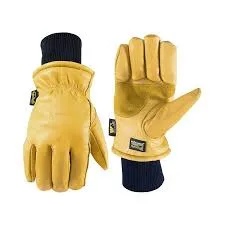The Different Types of Work Gloves and When to Use Them
The Different Types of Work Gloves and When to Use Them

It’s common knowledge that no matter what industry you’re in, as long as you’re working with your hands, you should be wearing work gloves. These garments not only protect your hands from injury while on the job, but they also guarantee you’re getting the best traction for the tasks you’re performing. Because of this, it’s crucial that each worker knows the different types of work gloves and when to use them properly.
Coated and Uncoated Fabric Gloves
Fabric gloves are the most common type of work glove on the market as they provide the standard level of protection for most basic tasks. Because of the thinness of the cotton fabric, they’re most useful for guarding against minor cuts, scrapes, or splinters sustained from handling materials. Though coated gloves provide a bit more protection than uncoated fabric, they too won’t provide as much protection from burns or punctures.
Working gloves
Leather Utility Gloves
Quality leather utility gloves are durable, insulated, and provide the wearer with a useful amount of grip. The materials that go into their design are significantly thicker than fabric and, as such, they’re great for performing jobs that need better overall protection. Because of this, using leather gloves is highly encouraged when working with utility lines and other burn hazards. These gloves do, however, tend to dry out and crack over time, making them less effective long term.
Puncture-Resistant Gloves
Another type of work glove is the puncture-resistant model. These gloves are made with intricately woven Kevlar materials to maximize protection and prevent sharp objects from breaking through the surface. The scale-like pattern that they’re interlaced with helps deflect sharp objects and significantly reduce the risk of injury. For these reasons, these gloves are perfect for those working with sharp scrap materials.
Aluminized Gloves
Designed for working in conditions of intense heat, aluminized gloves are best suited for welding projects and performing job duties with high-heat ovens. With an outward layering of aluminum-infused fabric, these items are heavily insulated and securely sewn together with strong Kevlar thread. This makes them not just incredibly tolerant of high temperatures, but also very flexible and easy to work with.
-
Northern Safety Clothing Supplier Cheap OEM & China Options
NewsJul.04,2025
-
High-Quality Auto Racing Safety Clothing Affordable & OEM Options from China
NewsJul.04,2025
-
Aero Safety Helmet - OEM Gomax Aero Adult Safety Helmet, Affordable Protection for Cyclists
NewsJun.10,2025
-
Buy uvex pheos abs alpine safety helmet – OEM & Cheap Options from China Supplier
NewsJun.10,2025
-
Volman Safety Helmet - Premium Durable Protection for Industrial Workers
NewsJun.10,2025
-
Top Safety Helmet Suppliers in UAE Reliable Brands & Affordability
NewsJun.10,2025

